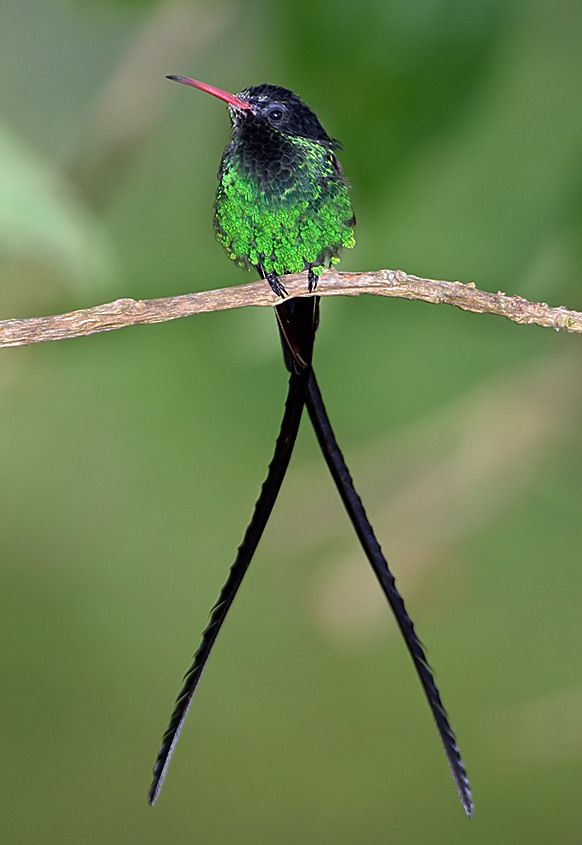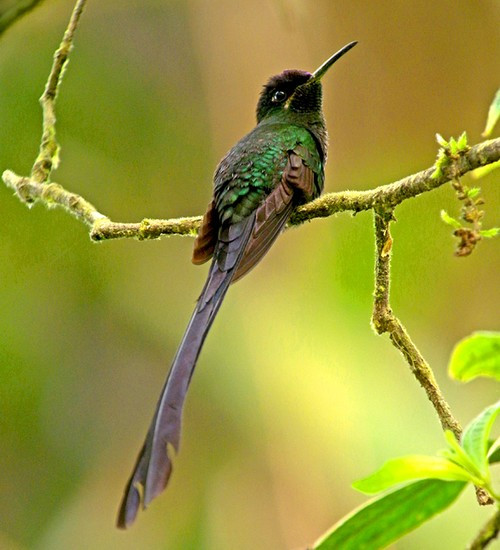Endangered Species Monday: Hylonympha macrocerca
Endangered Species Monday: Hylonympha macrocerca
This Monday’s Endangered Species Post (ESP) watch I take a rare glimpse into the life of Hylonympha macrocerca, commonly known as the Scissor Tailed Hummingbird. Identified in 1873 by Dr John Gould FRS September 1804 – 3 February 1881) whom was an English ornithologist and bird artist. He published a number of monographs on birds, illustrated by plates that he produced with the assistance of his wife, Elizabeth Gould, and several other artists including Edward Lear, Henry Constantine Richter, Joseph Wolf and William Matthew Hart. He has been considered the father of bird study in Australia and the Gould League in Australia is named after him. His identification of the birds now nicknamed “Darwin’s finches” played a role in the inception of Darwin’s theory of evolution by natural selection. (Image: Scissor Tailed Hummingbird)
Listed as (endangered) this remarkable specimen was listed as threatened back in 1988. Since this time little conservation efforts have been seen to improve the species overall status within the wild of which extinction is incredibly likely. From 1994 to 1996 the species was listed as critically endangered. From the start of the Millennium conservation efforts did improve the wild status of the hummingbird to (vulnerable), unfortunately from 2008 to date the species has been re-listed as endangered again. From my own evaluations of the birds current threats and shrinking habitat, extinction will occur within the next five to ten years, unless conservation efforts improve, funding increases and dangers disperse soon.
Endemic to Venezuela and Bolivia evidence has shown that overall population sizes are decreasing very rapidly. The population trend when last evaluated back in 2012, showed around 10,000 to 19,900 ‘individuals’ within the wild. This equates to exactly 6,000 to 13,000 ‘mature individuals’ remaining, which is rounded to 6,000 to 15,000 ‘birds in total’. The Scissor Tailed Hummingbird specie inhabits lower and upper montane humid forest, where it has been recorded at 800-1,200 m on Cerro Humo, and 530-920 m further east.
In primary forest, the specie feeds mainly at bromeliad flowers and on their insect inhabitants, whereas in secondary forest, feeding is associated with the shrubs Heliconia aurea and Costus sp. Although it is regularly seen feeding on Heliconia in open areas it may nevertheless be dependent on the availability of pristine forest nearby. It also hawks insects from exposed perches. There may be seasonal movements.
Major Threats
Listed on Cites Appendix II (Convention on International Trade of Endangered Species wild flora and fauna), increases in cash-crop agriculture, especially the cultivation of “ocumo blanco” (Xanthosoma sagittifolium) and “ocumo chino” (Colocasia esculenta), since the mid- to late 1980s have resulted in some uncontrolled burning and forest degradation. Cerros Humo and Patao have been worst affected, with the east of the peninsula fairly undisturbed.
Since it is an understorey inhabitant, removal of understorey vegetation for coffee and cacao cultivation is likely to lead to reduced population density. It is considered nationally Endangered in Venezuela, and has been recognized as a “high priority” species, amongst the top dozen priorities for bird conservation in Venezuela.
Image: Scissor Tailed Hummingbird.
Occasionally the species is misidentified as the Red-billed streamertail which is also commonly known as the scissor-tail or scissors tail hummingbird. However its fairly easy to distinguish between the two when viewing online or within books. This particular species (in question) is not native to Jamaica, and one can quite easily differentiate between the two. The Scissor Tailed Hummingbird has obviously acquired its name due to its unique scissor tailed rump feathers, whereas the Jamaican Red-billed streamertail doesn’t host the same features but more as explained - streamer like rump feathers.
Sadly as explained due to increasing threats we will lose this bird unless conservation efforts improve dramatically and dangers subside. However this is unlikely to occur. The Scissor Tailed Hummingbird will be yet another species of bird added soon to the extinction list of amazing birds, that we humans have destroyed. The video below depicts a female Scissor Tailed Hummingbird within the Venezuela wild.
Thank you for reading.
Dr Jose C. Depre.
Environmental and Botanical Scientist.





